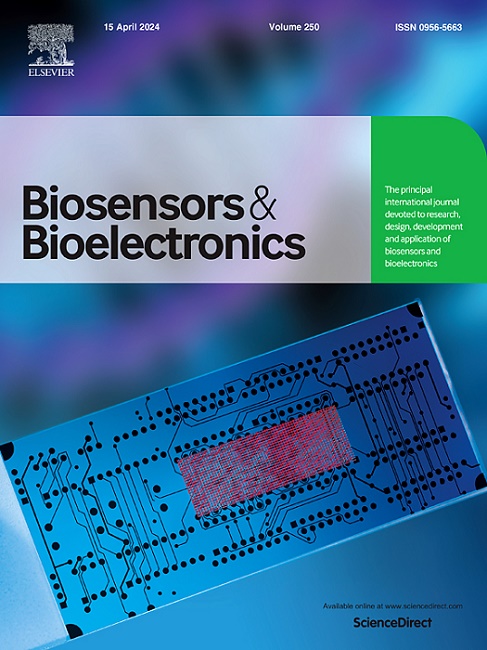Organic photoelectrochemical transistor biosensor based on BiVO4-ZnIn2S4 material for efficient and sensitive detection of MCF-7 cells
IF 10.5
1区 生物学
Q1 BIOPHYSICS
引用次数: 0
Abstract
Recently, organic photoelectrochemical transistor (OPECT) has become a very interesting biological measurement method in photoelectrochemical (PEC) bioanalysis and future bio-related applications. OPECT is expected to be a powerful tool for disease detection and early warning. Circulating tumor cells (CTCs) are generally deemed to be the dominant factor of tumor metastasis, and 90 % of cancer patients die from this metastatic disease. Therefore, there is an imminent need to develop a highly sensitive CTCs detection sensing system to improve the survival rate of cancer patients. Here, we use a DNA tetrahedrons (DNA NTH) with an aptamer at the top to immobilize on the surface of the photoelectric material to capture cells (MCF-7). Specifically, the BiVO4-ZnIn2S4 hybrid was synthesized by a simple hydrothermal method, which can effectively modulated devices with high current gain. Au NPs were directly integrated on the electrode surface to construct an OPECT photoelectric sensing platform. Subsequently, the aptamer which is thiol-functionalized (SH-Apt) was immobilized on the electrode surface. Because of the overexpression of MUC1 protein on the cell membrane, it can specifically capture MCF-7 cells. The introduction of MCF-7 cells resulted in a significant decrease in the current signal. There is a relationship between the change of photocurrent and the logarithm of MCF-7 cell concentration, which is a good linear relationship ranging from 50 to 5 × 105 cell mL−1. The obtained detection limit is 43 cell mL−1. The biosensor has high selectivity and sensitivity, and achieves sensitive detection of MCF-7.
基于BiVO4-ZnIn2S4材料的有机光电晶体管生物传感器高效灵敏地检测MCF-7细胞
近年来,有机光电电化学晶体管(OPECT)已成为光电化学(PEC)生物分析和未来生物相关应用中非常有趣的生物测量方法。OPECT有望成为疾病检测和早期预警的有力工具。循环肿瘤细胞(CTCs)被普遍认为是肿瘤转移的主要因素,90%的癌症患者死于这种转移性疾病。因此,迫切需要开发一种高灵敏度的ctc检测传感系统来提高癌症患者的生存率。在这里,我们使用顶部有适配体的DNA四面体(DNA NTH)固定在光电材料表面以捕获细胞(MCF-7)。具体来说,BiVO4-ZnIn2S4杂化物是通过简单的水热法合成的,它可以有效地调制具有高电流增益的器件。将金纳米粒子直接集成在电极表面,构建OPECT光电传感平台。随后,将巯基功能化的适体(SH-Apt)固定在电极表面。由于MUC1蛋白在细胞膜上过表达,可以特异性捕获MCF-7细胞。引入MCF-7细胞后,电流信号显著降低。光电流的变化与MCF-7细胞浓度的对数之间存在良好的线性关系,在50 ~ 5 × 105 cell mL−1范围内呈良好的线性关系。检测限为43 cell mL−1。该传感器具有较高的选择性和灵敏度,实现了对MCF-7的灵敏检测。
本文章由计算机程序翻译,如有差异,请以英文原文为准。
求助全文
约1分钟内获得全文
求助全文
来源期刊

Biosensors and Bioelectronics
工程技术-电化学
CiteScore
20.80
自引率
7.10%
发文量
1006
审稿时长
29 days
期刊介绍:
Biosensors & Bioelectronics, along with its open access companion journal Biosensors & Bioelectronics: X, is the leading international publication in the field of biosensors and bioelectronics. It covers research, design, development, and application of biosensors, which are analytical devices incorporating biological materials with physicochemical transducers. These devices, including sensors, DNA chips, electronic noses, and lab-on-a-chip, produce digital signals proportional to specific analytes. Examples include immunosensors and enzyme-based biosensors, applied in various fields such as medicine, environmental monitoring, and food industry. The journal also focuses on molecular and supramolecular structures for enhancing device performance.
 求助内容:
求助内容: 应助结果提醒方式:
应助结果提醒方式:


